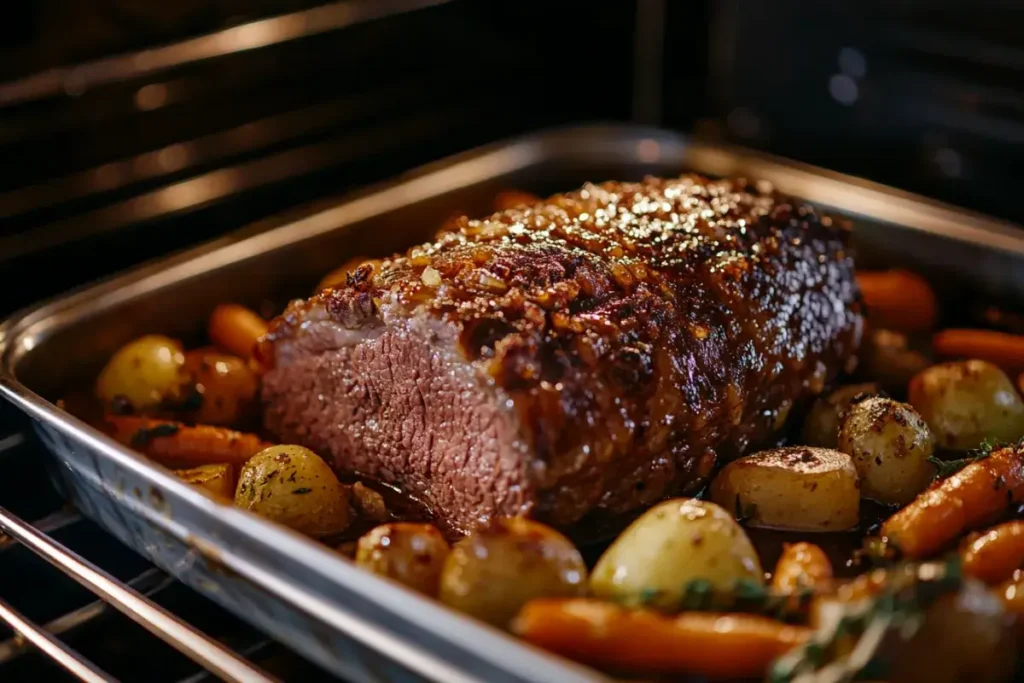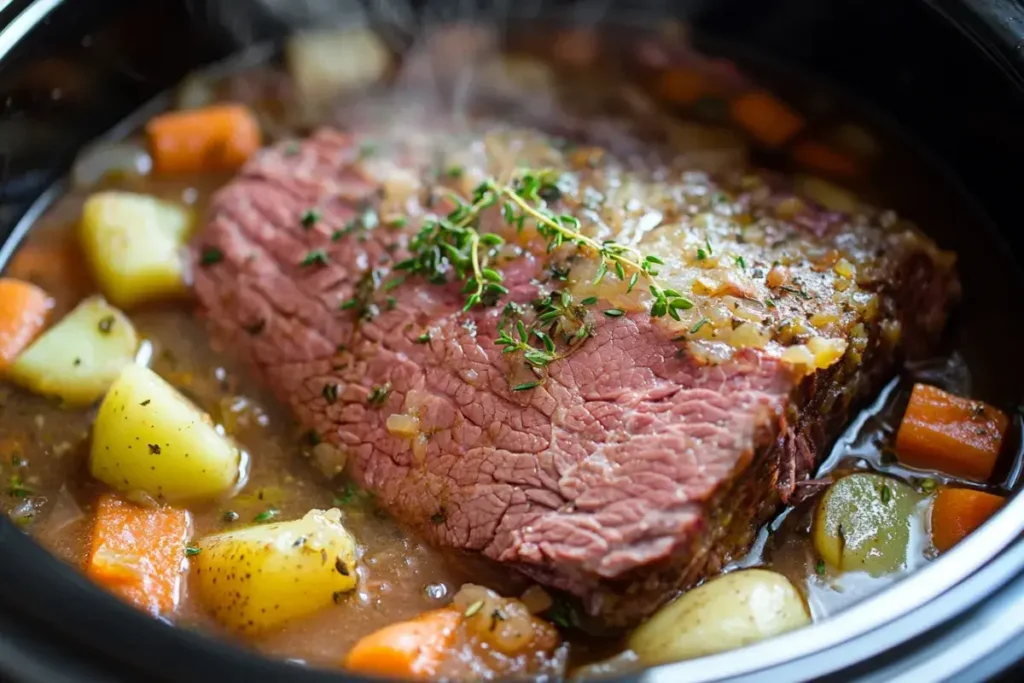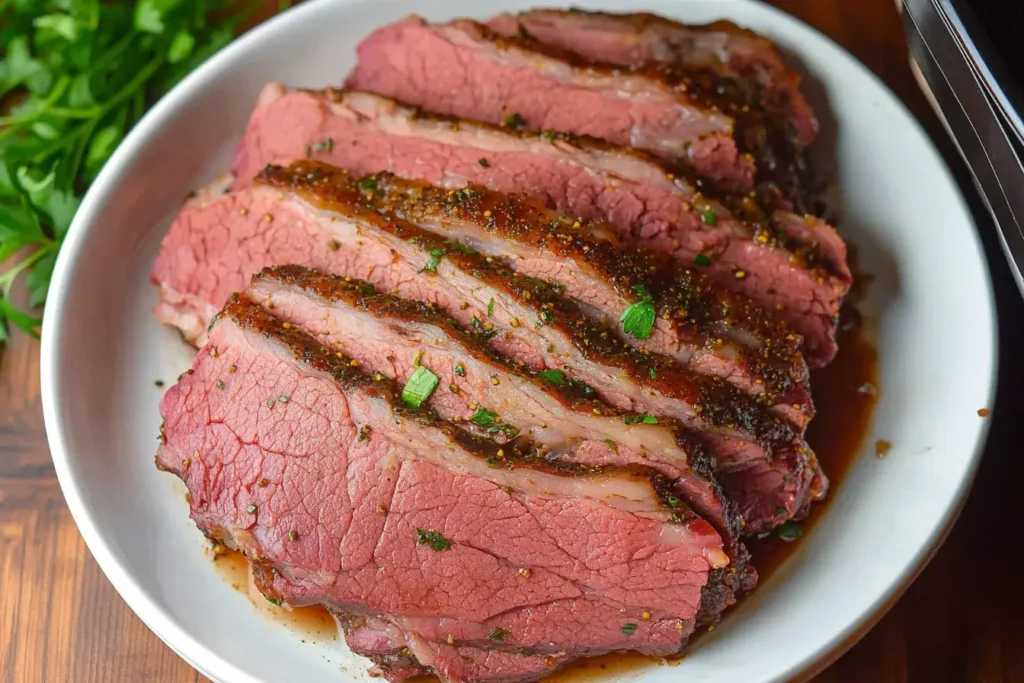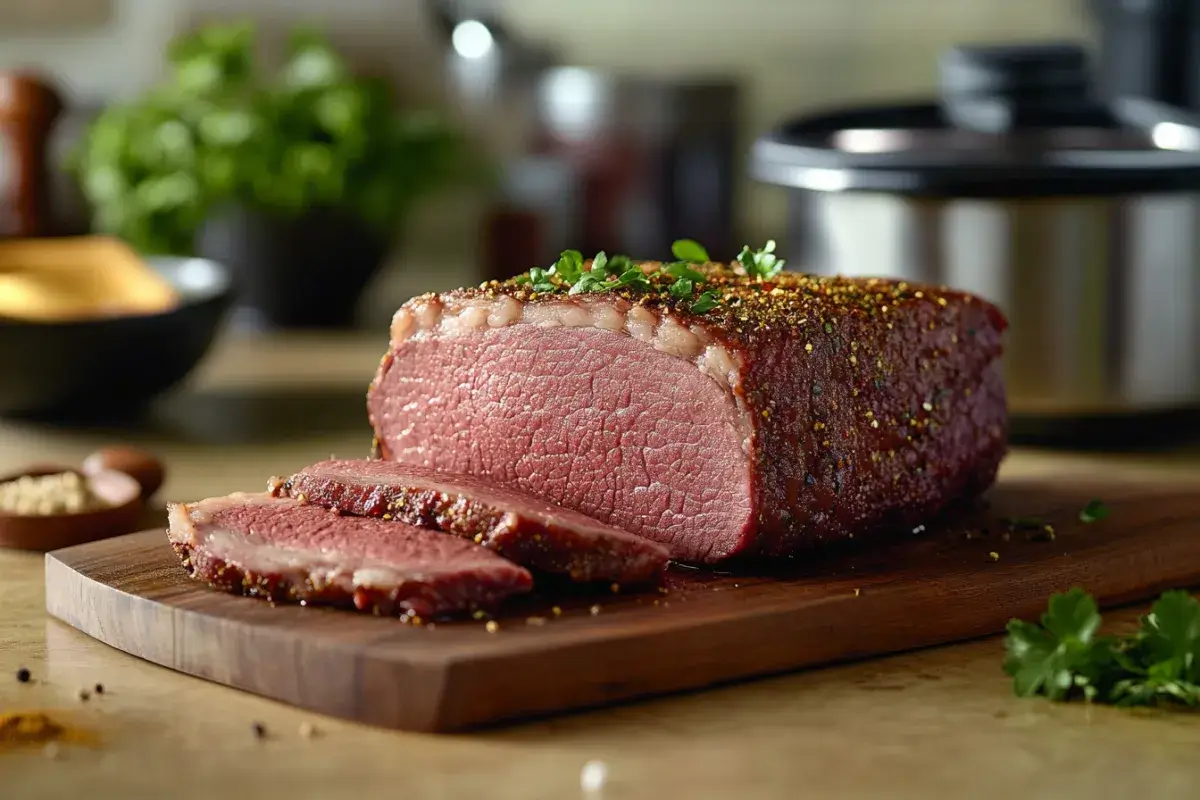Cooking corned beef can seem tricky, especially when aiming for a tender, juicy result. While it’s a beloved dish, it’s easy to end up with tough or dry meat if it’s not cooked right. So, with several methods available, how can you find the best one? This guide will explore the most effective techniques to achieve tender, flavorful corned beef.
Understanding Corned Beef: Why Does It Get Tough?
Before we look at the cooking methods, it’s important to understand what makes corned beef tough. Corned beef comes from the brisket cut, which is naturally a dense, fatty part of the cow. This meat is cured in salt, giving it its signature flavor, but it can also make it more challenging to cook to a tender texture. Without the proper technique, you may end up with chewy or dry meat.
One common cause of tough corned beef is improper cooking. Brisket needs slow cooking to break down its tough muscle fibers. If cooked too fast or at high heat, the meat doesn’t have time to tenderize. That’s why “low and slow” cooking is critical when preparing this dish.
If you’re curious about why slow cooking works, check out this in-depth guide on tenderizing meat. It explains how temperature affects the meat’s structure and why tougher cuts, like brisket, need extra care.
The Secret to Tender Corned Beef: Low and Slow Cooking
The best way to make corned beef tender is to cook it at a low temperature for an extended time. This slow process breaks down the collagen in the brisket, turning it into gelatin, which makes the meat soft and moist.
Cooking the meat too quickly or using high heat will lead to a tough, rubbery texture. Slow cooking gives the brisket time to tenderize, making the beef easier to slice and enjoy. For more tips on slow-cooking meat, check out this slow cooker guide, which shares helpful advice for achieving the perfect texture.
Top Cooking Methods for Tender Corned Beef
Now that we know why slow cooking is important, let’s explore the most popular ways to cook corned beef. While there are several methods to choose from, some deliver better results when it comes to tenderness.
Slow Cooker Method (Crockpot)
The slow cooker is one of the easiest and most effective methods for cooking tender corned beef. This method keeps the heat low and consistent for hours, which allows the meat to become tender without much effort.
How to cook corned beef in a slow cooker:
- Place the corned beef in the slow cooker. Cover it with water or broth (broth adds more flavor).
- Add garlic, onions, and any seasoning packet included with the beef.
- Cook on the low setting for 8–10 hours, allowing the meat to fully tenderize.
- If you want to add vegetables like carrots or cabbage, add them in the last 2 hours to avoid overcooking.
Why this method works:
- The low, consistent heat slowly breaks down the muscle fibers, ensuring the beef remains tender. Plus, the moisture keeps the meat juicy throughout the long cooking process.
Pro tip: For extra flavor, add mustard seeds, peppercorns, and bay leaves. Avoid lifting the lid frequently, as this can let heat escape and slow down the cooking process.
For a quicker alternative, consider using an Instant Pot, which can also produce tender corned beef in less time. Learn more about making corned beef in the Instant Pot here.
Stovetop Boiling Method
The traditional stovetop boiling method is another reliable way to cook corned beef. This approach involves simmering the meat in liquid for several hours.
How to boil corned beef:
- Thoroughly rinse the corned beef to wash away any excess salt left from the curing process.
- Transfer the beef to a large pot and completely submerge it with either water or broth.
- Heat the liquid until it reaches a boil, then lower the temperature to maintain a gentle simmer.
- Let the meat simmer for 3–4 hours, depending on its size. Make sure the heat stays low to avoid toughening the meat.
- Add vegetables in the final hour if desired.
Why this method works:
- The slow simmer helps the beef cook evenly, while the water or broth keeps the meat from drying out. The long, gentle cooking time allows the brisket to tenderize and absorb flavors.
Helpful tip: Keep an eye on the water level. You may need to add more liquid as it evaporates. Maintaining a gentle simmer, rather than a rolling boil, is key to tender results.
Oven-Baked Method (Roasting)
Roasting corned beef in the oven isn’t as common, but it’s a great way to create deep flavors while keeping the meat tender. The key is using low heat and moisture to prevent drying out.

How to roast corned beef:
- Preheat your oven to 300°F.
- Place the corned beef on a large sheet of aluminum foil, fat side up. Add garlic, onions, or spices around the meat.
- Wrap the beef tightly in the foil, ensuring no steam escapes. Add a small amount of broth to the foil packet for extra moisture.
- Bake for 3–4 hours. Check for doneness by piercing the meat with a fork—it should be tender and easy to pull apart.
- Let the meat rest for 10–15 minutes before slicing.
Why this method works:
- The foil traps steam, which helps keep the meat moist while it cooks. The low heat ensures the brisket has enough time to soften and become flavorful.
Pro tip: You can add a shallow pan of water to the oven to create a steamy environment, further ensuring the meat remains tender.
Pressure Cooker (Instant Pot) Method
If you’re short on time but still want a tender result, the pressure cooker (or Instant Pot) is an excellent choice. This method speeds up the cooking process without sacrificing texture.

How to cook corned beef in a pressure cooker:
- Place the corned beef in the pressure cooker. Add enough water or broth to cover it.
- Set the cooker to high pressure and cook for 90 minutes.
- Once done, allow the pressure to release naturally, which helps keep the meat tender.
- After cooking, let the beef rest for 10 minutes before slicing.
If your Instant Pot corned beef turns out tough, there are simple fixes. Check out this guide on how to fix tough corned beef in the Instant Pot here
Why this method works:
- The pressure cooker uses steam and high pressure to break down the tough fibers quickly, while still maintaining moisture and flavor.
Sous Vide Method for Corned Beef
If precision is your goal, then the sous vide method is an excellent way to achieve tender, juicy corned beef. While this method requires specialized equipment, like a sous vide machine and vacuum sealer, it offers unmatched control over temperature. Cooking sous vide means you can set the exact temperature you want and maintain it for long periods, ensuring perfectly even cooking from edge to center.
How to cook corned beef sous vide:
- To begin, season the corned beef with your desired spices and place it into a vacuum-sealed bag. Next, preheat the sous vide water bath to 180°F (82°C). Once the water bath is ready, submerge the vacuum-sealed bag and allow it to cook for 10–12 hours. After the time is up, carefully remove the corned beef from the bag. Then, let it rest for 10 minutes before slicing it against the grain.
Why it works:
- The sous vide method works so well because it allows for precise control of the cooking temperature, which prevents the meat from overcooking. Additionally, the extended cooking time breaks down the meat’s collagen, ensuring that the beef stays both moist and tender.
Advantages:
- Consistent, foolproof results.
- Retains moisture and flavor due to vacuum sealing.
Disadvantages:
- Requires extra equipment (sous vide machine and vacuum sealer).
- Longer cooking time, though hands-off.
How to Know When Corned Beef is Done and Tender
The goal with corned beef is to reach that perfect fork-tender texture. How do you know when it’s ready? There are a few easy ways to check.
- Internal temperature: If you’re looking for tips on cooking tender corned beef, checking the internal temperature is crucial. The ideal temperature range for fully cooked corned beef is 195°F to 205°F (90°C to 96°C). Cooking it to this range allows the connective tissues to break down, resulting in tender meat.
- Tenderness check: Insert a fork into the meat. If it goes in easily and the meat pulls apart with little effort, it’s ready to serve.
- Visual cues: If the corned beef looks soft and moist on the inside, with a slightly firmer outer layer, it’s cooked to perfection.
Resting Corned Beef for Maximum Tenderness
After cooking your corned beef, it’s essential to let it rest before slicing. Resting allows the juices to redistribute within the meat, helping it stay moist when cut.
Why resting matters:
- Cutting the beef immediately after cooking can cause the juices to leak out, leaving the meat dry.
- Resting gives the fibers time to relax and reabsorb the juices, leading to a more tender and flavorful result.
How to rest corned beef:
- Once you’ve removed the meat from the heat, wrap it loosely in aluminum foil and let it sit for 10–15 minutes before slicing.
Slicing Corned Beef for Tenderness
Even if you’ve cooked your corned beef perfectly, improper slicing can make the meat seem tougher. To ensure each bite is tender, it’s crucial to slice against the grain.
Steps for proper slicing:
- Locate the direction of the grain. This refers to the lines of muscle fibers running through the meat.
- Using a sharp knife, cut perpendicular to the grain. This shortens the fibers, making the meat easier to chew and more tender.
By slicing with the grain, you’ll leave the fibers long, which can result in a tougher, chewier texture. Always slice against the grain to enjoy the full tenderness of your corned beef.
Common Mistakes to Avoid When Cooking Corned Beef
Even with the best methods, mistakes can happen. Here are some common errors that can make your corned beef less than ideal:
- Overcooking or undercooking: Both can ruin the texture. Overcooking will cause the meat to dry out, while undercooking can leave it tough. Always use a meat thermometer to check for an internal temperature of at least 195°F (90°C).
- Cooking at too high a temperature: High heat can quickly toughen the meat. Stick to low and slow methods to break down the connective tissue properly.
- Slicing incorrectly: As mentioned, slicing with the grain instead of against it will result in longer muscle fibers, which are harder to chew.
- Skipping the resting period: Letting the corned beef rest is critical for retaining moisture. If you skip this step, you risk losing much of the meat’s natural juices.
Tips for Storing and Reheating Leftover Corned Beef
If you have leftover corned beef, storing it correctly will help maintain its tenderness when you’re ready to enjoy it again.

Storing leftovers:
- In the fridge: Store leftover corned beef in an airtight container in the refrigerator for up to 3–4 days.
- In the freezer: If you want to keep it longer, you can freeze the meat. Wrap it tightly in plastic wrap and then in aluminum foil, or place it in a freezer-safe container. It will keep for up to 2–3 months.
Reheating corned beef:
- Oven: Preheat the oven to 275°F (135°C). Place the beef in a baking dish, add a small amount of broth or water, and cover it with foil. Heat for about 20–30 minutes, or until warmed through.
- Stovetop: Steam the corned beef over a small amount of water. This method helps retain moisture and prevents the meat from drying out.
- Microwave: For a quick option, microwave small portions. Place the beef on a microwave-safe plate and cover it with a damp paper towel. Heat in short intervals to avoid overcooking.
Frequently Asked Questions (FAQs)
Can I cook corned beef from frozen?
It is possible to cook corned beef from frozen, though it will require additional cooking time. When using methods like slow cooking or boiling, add approximately 50% more time. For pressure cooking, you’ll need to add about 10–15 minutes.
Which portion of beef is selected for making corned beef?
Corned beef typically comes from the brisket, which is a tough cut from the lower chest of the cow. Brisket is ideal for corning due to its muscle structure, which becomes tender when cooked slowly. Occasionally, cuts like the round can be used, but brisket remains the most common.
Why is my corned beef tough and chewy?
Tough corned beef is usually a result of cooking it too fast or at too high a temperature. Brisket needs slow cooking at low temperatures to break down its fibers. Make sure to cook it slowly and ensure it reaches the correct internal temperature for best results.
Should I rinse corned beef before cooking?
Yes, rinsing corned beef before cooking helps remove excess salt from the curing process. This step prevents the final dish from being too salty. Simply rinse the meat under cold water before cooking, and pat it dry with paper towels.
How can I make corned beef more flavorful?
To boost flavor, consider adding aromatics like garlic, bay leaves, peppercorns, and onions to the cooking liquid. You can also marinate the meat before cooking or experiment with spice rubs. For a rich taste, cook the beef in broth instead of plain water.
Conclusion: Finding the Right Method for You
Ultimately, the best way to cook corned beef depends on your preferences and the time you have. The slow cooker remains a great choice for those looking for a hands-off method that guarantees tenderness. Oven roasting offers rich flavors, while stovetop boiling is a traditional, reliable option. If you’re short on time, the pressure cooker delivers fast, tender results. And for ultimate precision, sous vide is hard to beat.
No matter which method you choose, remember that cooking corned beef slowly and allowing it to rest afterward are key to achieving a tender, flavorful meal. With these tips and techniques, you’ll be able to enjoy perfectly cooked corned beef every time.

